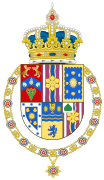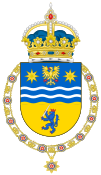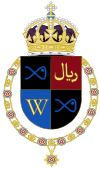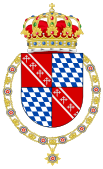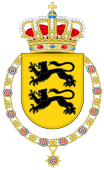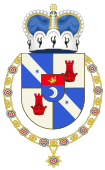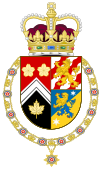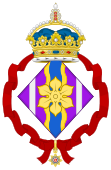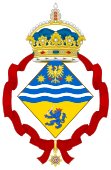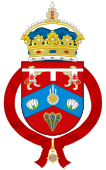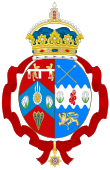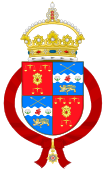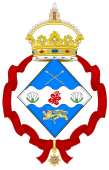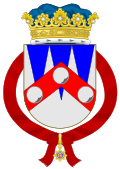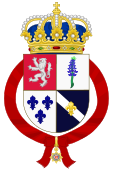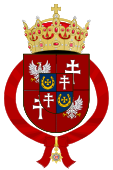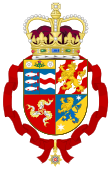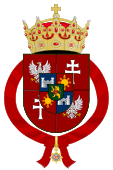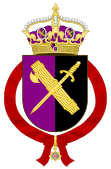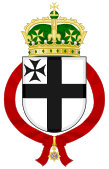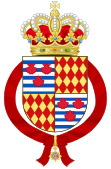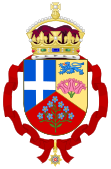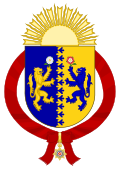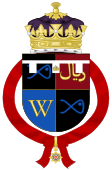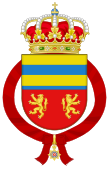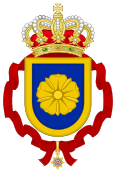Supreme Order of the Hibiscus
| The Most Esteemed Supreme Order of the Hibiscus परम प्रतिष्ठित दर्ज़ह उत्तम जावाकुसुम Param Pratishthit Darjah Utama Javakusuma | |
|---|---|
 Badge of the Supreme Order of the Hibiscus | |
Awarded by the Rashtradhyaksh of Vishwamitra | |
| Type | Chivalric order |
| Established | 24 October 2022 |
| Eligibility | State and foreign dignitaries |
| Awarded for | highest level of dedication for the development and progress of Vishwamitra and towards the welfare of all the people of Vishwamitra |
| Status | Currently constituted |
| Sovereign | HIllRM The Rashtradhyaksh |
| Chancellor | HM The Uparashtradhyaksh |
| Grades | Collar Grand Cordon |
| Post-nominals | S.U.K. D.U.K. |
| Statistics | |
| First induction | 25 October 2022, Varuna Sriraya of Purvanchal |
| Last induction | 30 July 2023, Arthur I of Creek and Lake |
| Total inductees | Total: 43 • Collar: 18 • Grand Cordon: 25 |
| Precedence | |
| Next (higher) | None (highest) |
| Next (lower) | Order of the Foxtail Orchid |
Ribbon bar | |
The Most Esteemed Supreme Order of the Hibiscus (Hindi: परम प्रतिष्ठित दर्ज़ह उत्तम जावाकुसुम, Param Pratishthit Darjah Utama Javakusuma) is the second highest and order of chivalry of Vishwamitra which was created on 24 October 2022[1] by Rashtradhyaksh Varuna Sriraya through his royal decree numbered 247-2022 under the various reforms initiated to the federal honours system. The order, being the highest and senior-most of all, is conferred upon "an individual" who has depicted highest level of dedication for the development and progress of Vishwamitra and towards the welfare of all Vishwamitran people. The order replaced the Royal Family Order of Vishwamitra which was disestablished by the same royal decree. Until the creation of the Order of the Royal Family of Vishwamitra on 17 January 2024, the Supreme Order of the Hibiscus was the highest chivalric order.
The composition and induction criteria of the order is highly inspired and based upon the Japanese Supreme Order of the Chrysanthemum.
History
The now-defunct, Royal Family Order of Vishwamitra, was created as the highest and senior-most order by the first Rashtradhyaksh Tanishkaa Patranabish on 3 July 2020 initially to confer it upon a state ruler who became the Rashtradhyaksh. Her successor and current Rashtradhyaksh Varuna Sriraya amended said order to open the order to the other state rulers, senior royalties and reigning foreign monarchs of recognized sovereign states. However, in October 2022, there were several proposals for a much streamlined honours system and subsequently the privy council deliberated and discussed on several options regarding the proposals. Finally, it was decided by the Rashtradhyaksh that the Royal Family Order of Vishwamitra along with all the other federal chivalric orders shall be disestablished and replaced by other appropriate orders.
The Supreme Order of the Hibiscus was thereby created as a replacement to the Royal Family Order, the Order of the Sanghamitra and partly to the Order of the Lotus and thus became the nation's highest order.
Grades, eligibility, and insignia
Grades
The Rashtradhyaksh is at the apex of the order as the fons honorum as the sovereign. Following the sovereign is the Chancellor of the order, a position held by one of the members of the order. The current Chancellor of the order is His Majesty Uparashtradhyaksh Bishnu Chetry, Rajpramukh of Uttaranchal.
The order is bestowed in two classes:
- Collar or Special Class or Darjah Sri Utama Javakusuma - S.U.K. (limited to 25 living recipients)
- Grand Cordon or First Class or Darjah Utama Javakusuma - D.U.K. (limited to 100 living recipients)
Eligibility
The Supreme Order of the Hibiscus is bestowed upon the rulers of the states, the members of the royal families of the states, foreign heads of recognized states, members of recognized foreign royal families and in exceptional cases, upon citizens of Vishwamitra as a token of respect for their contributions towards Vishwamitra.
The Collar grade is exclusively conferred on the rulers of the states, reigning monarchs of sovereign states and serving foreign heads of state. The collar is limited only to 25 living recipients excluding the rulers of the states who are extranummery recipients of the grade.
The Grand Cordon grade is conferred on members of the royal families, foreign heads of recognized states and their spouses, members of foreign royal families, and on citizens of Vishwamitra.
The order is exclusively reserved for foreign heads of state and royalties of states which are formally recognized by the Government of Vishwamitra.
Insignia
The insignia of the order consists of the collar, a sash or riband, the star and the badge of the order.
- The collar includes the star of the order attached by the crown of the order to the chain which is made up of 13 pieces bearing the Hibiscus or Hibiscus rosa-sinensis flower and the crown of Vishwamitra in alternate fashion.
- The sash of the order is a red silk riband to which the badge of the order is hung at the bow attached by the crown of Vishwamitra. The sash is worn from the left shoulder to the right hip.
- The star of the order is an eight pointed gold glittered star with a floral design in gold and silver with a white over a blue disc topped by the Hibiscus flower in red with five diamonds in its center.
The recipients of the Collar grade receive the insignia of the collar, a sash, the badge and the star of the order. On ceremonial occasions, only the collar of the order maybe worn along with the badge.
The recipients of the Grand Cordon grade receive the sash, the badge and the star of the order. The sash is worn from the left shoulder to the right waist.
| Insignia of the Most Esteemed Supreme Order of the Hibiscus | ||
|---|---|---|
| Grade | Collar | Grand Cordon |
| Post-nominals | S.U.K. | D.U.K. |
| Insignia | 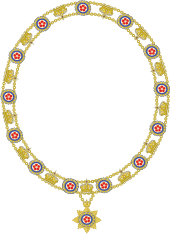 
|
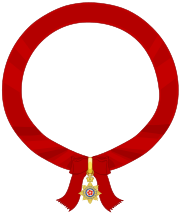 
|
| Ribbon bars | ||
Recipients
Sovereign
- His Illustrious and Royal Majesty Varuna Sriraya, Rashtradhyaksh of Vishwamitra (since 25 October 2022)
Collars (S.U.K.)
- 25 October 2022: Bishnu Chetry, Rajpramukh of Uttaranchal[2]
- 25 October 2022: Tanishkaa Patranabish, Rajpramukh of Beltola[2]
- 25 October 2022: Arnab Sil, Rajpramukh of Madhya Prant[2]
- 25 October 2022: Anirban Phatowali, Rajpramukh of Kamrupa[2]
- 25 October 2022: Anoushkaa Patranabish, Rajpramukh of Basistha[2]
Grand Cordons (D.U.K.)
- 25 October 2022: Princess Sarala, Crown Princess of Purvanchal[2]
- 25 October 2022: Princess Asmi, Senior Princess of Beltola[2]
- 25 October 2022: Princess Arnisha, Senior Princess of Kamrupa[2]
- 25 October 2022: Prince Debajyoti, Prince Father of Purvanchal[2]
- 25 October 2022: Prince Abhiraj of Purvanchal[2]
- 25 October 2022: Princess Bishakha of Purvanchal[2]
- 12 November 2022: Princess Krishna, Princess Mother of Purvanchal[3]
- 15 October 2023: Farhaz Hazarika, Prime Minister
- 11 January 2024: Ștefan Marius Snagoveanu, former Prime Minister
- 11 January 2024: Phillip Joseph Pillin, former Prime Minister
Honorary recipients
Collars (S.U.K. (M))
- 25 October 2022: King Philip Joseph Pillin of Pibocip[2]
25 October 2022: King Arthur II of Ebenthal[2] (returned 2 December 2022)- 25 October 2022: King Jayden I of Novus Hierosolymis[2]
- 6 November 2022: Jonathan I, Emperor of Austenasia[4][a]
- 12 November 2022: Cloe, Sovereign Princess of Sancratosia[3]
- 24 November 2022: King John of Baustralia[5]
- 1 December 2022: King William I of Gradonia[6]
- 1 December 2022: King Sanghaya of Kaleido (then President)[7]
- 11 January 2023: Nicholas I, Grand Duke of Flandrensis[8]
- 11 January 2023: Christoph II, Archduke of Mimas[8]
- 11 January 2023: King Tyler Mullins I of New Athens[8]
- 11 January 2023: King Albert of Queensland[8]
- 15 April 2023: Pao, Emperor of Huai Siao[9]
- 30 July 2023: King Arthur I of Creek and Lake[10]
- 8 October 2023: Adrian Wojtasz, President of GSMLL[11]
Grand Cordons (D.U.K. (M))
- 25 October 2022: King Alexander I Constantine of Monmark[2]
- 25 October 2022: King Frederick Stanislaus Augustus of Litvania[2]
- 25 October 2022: King Albert of Queensland (then Prince)[2]
- 25 October 2022: Adrian Wojtasz, President of Upper Shwartz Morgen Lorgen Land[2]
- 6 November 2022: Terry, Emperor Father of Austenasia (former Emperor)[4][a]
- 12 November 2022: Princess Benedikte of Queensland (then Queen)[3]
- 21 November 2022: King Charles of Cheskgariya[12]
- 11 January 2023: Praeniy Naemal Seok, Mēk of Mekniy-Lurk[8]
- 11 January 2023: Julian I, Imperial Grand Duke of Lundenwic[8]
11 January 2023: Rory I, former Emperor of Lurdentania[8](revoked 10 July 2023[13])- 11 January 2023: Aggelos I, Emperor of Imvrassia[8]
- 11 January 2023: King Sander II of Revalia[8]
- 11 January 2023: King Alexander of the Nortonians[8]
- 11 January 2023: Princess Juliana of Queensland (former Queen)[8]
- 15 April 2023: Olivier I, Emperor of Angyalistan[9]
- 15 April 2023: Ștefan Marius Snagoveanu, President of Snagov[9]
- 15 April 2023: Arsal Abbas Mirza, Supreme Leader of Arsalania[9]
- 15 April 2023: Prince Eun Jo, Prime Minister of Huai Siao[9]
- 30 July 2023: Princess Katelynn, Duchess of Concord[10]
- 29 October 2023: Prince John, Duke of Kingston
- 11 January 2024: Caesar Paul I of Macalos
- 11 January 2024: Queen Marina I of Manso
Armorials
| Collars of the Most Esteemed Supreme Order of the Hibiscus |
|---|
|
| Grand Cordons of the Most Esteemed Supreme Order of the Hibiscus |
|---|
|
See also
References and notes
References
- ↑ "Royal Decree No. 247-2022". Google Docs. Rashtradhyaksh of Vishwamitra. 2022. Retrieved 11 September 2023.
- ↑ 2.00 2.01 2.02 2.03 2.04 2.05 2.06 2.07 2.08 2.09 2.10 2.11 2.12 2.13 2.14 2.15 2.16 2.17 "Royal Decree No. 248-2022". Google Docs. Rashtradhyaksh of Vishwamitra. 2022. Retrieved 11 September 2023.
- ↑ 3.0 3.1 3.2 "Royal Decree No. 251-2022". Google Docs. Rashtradhyaksh of Vishwamitra. 2022. Retrieved 11 September 2023.
- ↑ 4.0 4.1 "Royal Decree No. 250-2022". Google Docs. Rashtradhyaksh of Vishwamitra. 2022. Retrieved 11 September 2023.
- ↑ "Royal Decree No. 254-2022". Google Docs. Rashtradhyaksh of Vishwamitra. 2022. Retrieved 11 September 2023.
- ↑ "Royal Decree No. 256-2022". Google Docs. Rashtradhyaksh of Vishwamitra. 2022. Retrieved 11 September 2023.
- ↑ "Royal Decree-256/2022: Grant of Collar of the Supreme Order of the Hibiscus on King Sanghaya (1 December 2022)".
- ↑ 8.00 8.01 8.02 8.03 8.04 8.05 8.06 8.07 8.08 8.09 8.10 "Royal Decree No. 258 (2/2023)". Google Docs. Rashtradhyaksh of Vishwamitra. 2022. Retrieved 11 September 2023.
- ↑ 9.0 9.1 9.2 9.3 9.4 "Royal Decree No. 264 (8/2023)". Google Docs. Rashtradhyaksh of Vishwamitra. 2022. Retrieved 11 September 2023.
- ↑ 10.0 10.1 "Royal Decree No. 265 (9/2023)". Google Docs. Rashtradhyaksh of Vishwamitra. 2023. Retrieved 27 May 2023.
- ↑ "OFFICE OF THE RASHTRADHYAKSH - GRANT OF SUPREME ORDER OF THE HIBISCUS". Google Docs. Gazette of Vishwamitra. 2023. Retrieved 8 October 2023.
- ↑ "Royal Decree No. 253-2022". Google Docs. Rashtradhyaksh of Vishwamitra. 2022. Retrieved 11 September 2023.
- ↑ "The Gazette of Vishwamitra". Google Docs. Government of Vishwamitra. 2023. Retrieved 22 July 2023.
Notelist
- ↑ 1.0 1.1 Given as a gift for the marriage of Jonathan I.
